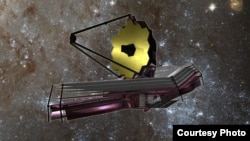A team of astronomers used the James Webb Space Telescope, or JWST, to observe a new, Jupiter-like planet outside our solar system – known as an "exoplanet." It was the first new planet observed and imaged with the telescope that was not first observed from Earth.
The astronomers, from the Max Planck Institute for Astronomy in Heidelberg, Germany, published a report on their discovery this week in the scientific journal Nature.
The lead author of the study, Elisabeth Matthews, described the planet as a gas giant, much like Jupiter in our own solar system, only six times its mass and much colder, with an average surface temperature of 0 degrees Celsius. It also has an elliptical orbit around its star and can take anywhere from 100 to 250 Earth years to orbit it.
Matthews said the planet is close, by exoplanet standards, at about 12 light-years away, and in a triple-star system. She said astronomers had known about the star system and, by studying it, had theorized a planet existed there, but needed the JWST to confirm it.
Matthews and her team wanted to take a picture of the known planet using a method commonly known as direct imaging. Since the stars in the system are so bright, they outshine any other nearby object.
The team employed the JWST’s camera equipped with a light-block mask that covered the star’s light, allowing the observers to see objects around it.
She said, though, that once they aimed the telescope’s camera in the direction of the star system, the planet was not in the position they had thought it would be, because they had underestimated the mass of the planet and its orbital separation from its star.
Matthews told The Associated Press that they could not have confirmed the existence of the planet without the JWST, and that the finding illustrated just how well the telescope is working.
“It really shows that we can image these planets, and we're still, for the moment, still imaging Jupiter and bigger planets." She said that in the future, by using the telescope, they also would be able to image smaller planets.
Launched in 2021 as an international collaboration among NASA, the European Space Agency and the Canadian Space Agency, the JWST is the largest and most powerful astronomical observatory ever placed in space. Unlike its predecessor, the Hubble Space Telescope, the JWST orbits the sun, not the Earth.
Some information for this report came from The Associated Press.
